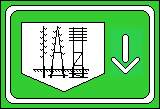|
The poles are 5-8 m tall normal wood ones in telephone and railway's telephone and signal system. The river dam flood protection used concrete poles. Hungary is not so rich in wood since 1920, the woods's quality is not the best because the wood poles need concrete foots. The present times the telephone companies use alike wood poles but they are green and not brown. The pole manufacturer uses a cloric chemical in place of the tar.
Pole constructions:
-Single hook pin for one Insulator, everywhere were them used, the cheapest construction
-Double side arm for two Insulators, old material, but lot of from them were used on point-o-point lines
-4 pins crossarm from U-prifile: The commonest on point-o-point lines
-J pins crossarms for 4 Insulators from U-rofile: The commonest and cheaper than the 4 pin one on point-o-point lines,
-8 pins double pole crossarms from U-rofile: For double poles in point-o-point lines
-4 pins long crossarm from U-profile: Carrier frequency crossams on point-o-point lines
-6 pins crossarms from L-profile: The commonest crossam in local and urban lines.
-2 pins and 10 pins L-profiles are not on the picures, they were used on roof-holders mostly.
-Terminal poles are from 4 pins U or 6 pins L profile only. Above every crossarms are a "tin channel", a channel with porcelain rings which keeps dry a part of the insulated wire, because of it the top crossarm is empty. It is alone Hungarian construction than the Napoleon Hat terminal Insulator. On the terminal poles are mostly transposition Insulators for the "in line" dead ends or "looks it for strain", it needs one pole and not two. The normal dead ends use normal Insulators.
-On a pole were not mixed the U and L-profile crossarms, but the same type crossarms can work in any variation. The L-profile is for the local urban lines, the U-profile for the point-o-point lines only. The railways didn't keep on these system, it used 6 pin L profile too, but the side arms were on point-o-point lines only.
|





